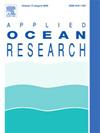Investigation of morphodynamic response to the storm-induced currents and waves in the Bay of Bengal
IF 4.3
2区 工程技术
Q1 ENGINEERING, OCEAN
引用次数: 0
Abstract
Storm surges, driven by Tropical Cyclones (TCs), pose a threat to the coastal areas of the Bay of Bengal (BoB), causing sediment transport and beach erosion. This study introduces a coupled hydrodynamic (TELEMAC-2D) -wave (TOMAWAC) -morphodynamic (GAIA) model to investigate morphodynamic changes during storm surges. The cyclonic wind is crucial for precisely predicting storm surges, wind waves, and morphodynamic bed evolution. Thus, this study introduced a modified parametric wind model to enhance wind field representation near and far from the cyclone center. The simulated storm surges and wind waves were validated against in-situ observations for TC Hudhud (2014) and TC Varadah (2016), and the simulated morphodynamic bed evolution was validated with field-measured data collected for TC Nivar (2020). Further, this study evaluates the performance of different bed load transport formulations for predicting morphodynamic bed evolution during TC Nivar (2020) under storm-induced currents and waves. Results indicate that the Engelund-Hansen model is most effective for currents alone, while the Bijker model excels for combined currents and waves along the open coast of BoB. The results also indicate that the incorporation of the effect of waves along with currents has enhanced the predictive capability of the coupled model framework.
孟加拉湾风暴引起的海流和海浪的形态动力学响应研究
由热带气旋(TC)驱动的风暴潮对孟加拉湾(BoB)沿岸地区构成威胁,造成沉积物迁移和海滩侵蚀。本研究采用水动力(TELEMAC-2D)-波动力(TOMAWAC)-形态动力(GAIA)耦合模型来研究风暴潮期间的形态动力变化。旋风对于精确预测风暴潮、风浪和海床形态演变至关重要。因此,本研究引入了一个改进的参数风模型,以增强气旋中心附近和远处风场的代表性。模拟的风暴潮和风浪与 TC Hudhud(2014 年)和 TC Varadah(2016 年)的现场观测数据进行了验证,模拟的海床形态演变与 TC Nivar(2020 年)的现场测量数据进行了验证。此外,本研究还评估了不同的床面负荷运移公式在风暴诱导的海流和波浪作用下预测尼瓦尔风暴潮(2020 年)期间床面形态演变的性能。结果表明,Engelund-Hansen 模型对单独的海流最为有效,而 Bijker 模型对波罗的海开阔沿岸的海流和波浪的组合最为有效。结果还表明,将波浪的影响与海流结合起来,增强了耦合模型框架的预测能力。
本文章由计算机程序翻译,如有差异,请以英文原文为准。
求助全文
约1分钟内获得全文
求助全文
来源期刊

Applied Ocean Research
地学-工程:大洋
CiteScore
8.70
自引率
7.00%
发文量
316
审稿时长
59 days
期刊介绍:
The aim of Applied Ocean Research is to encourage the submission of papers that advance the state of knowledge in a range of topics relevant to ocean engineering.
 求助内容:
求助内容: 应助结果提醒方式:
应助结果提醒方式:


